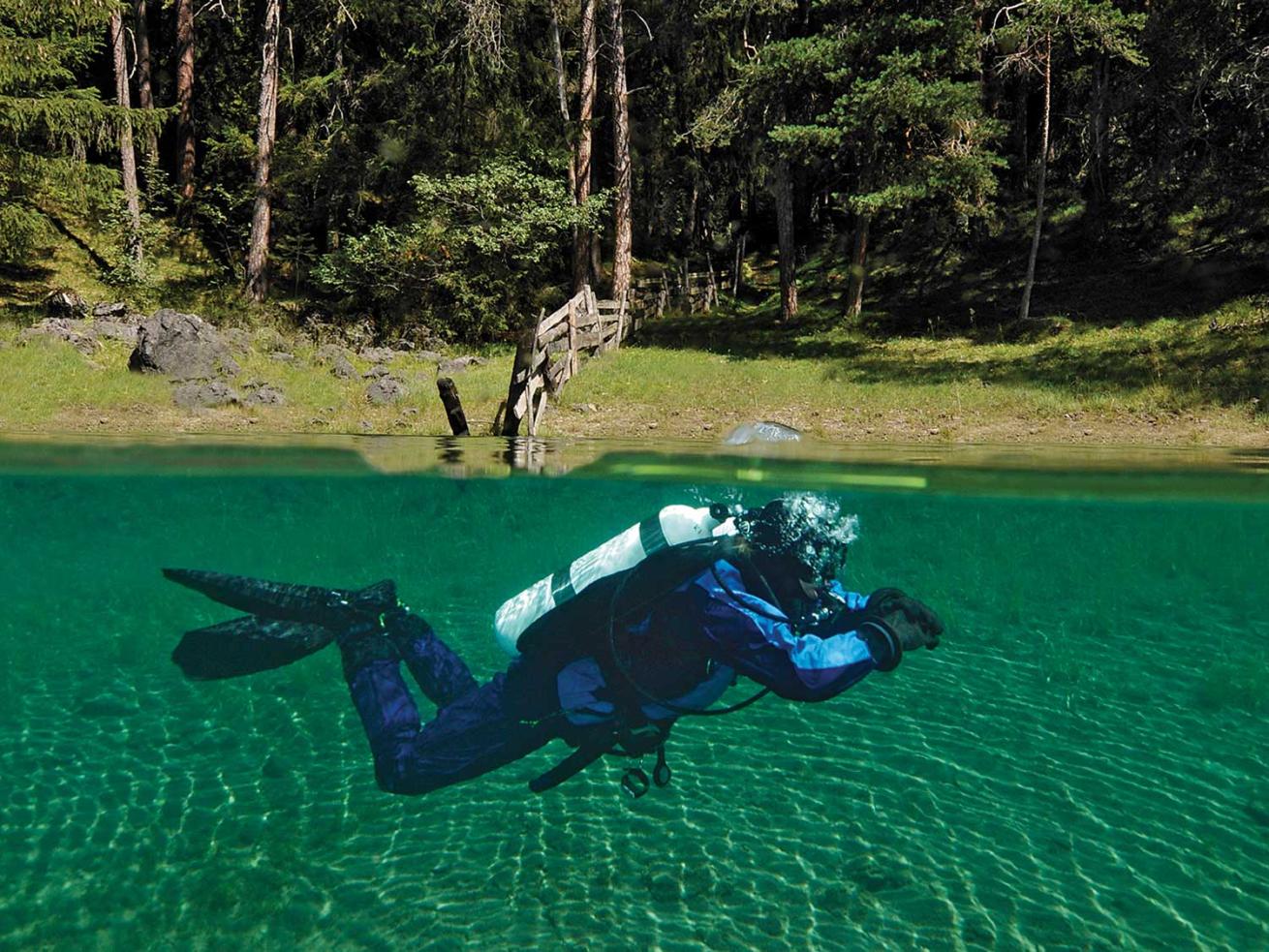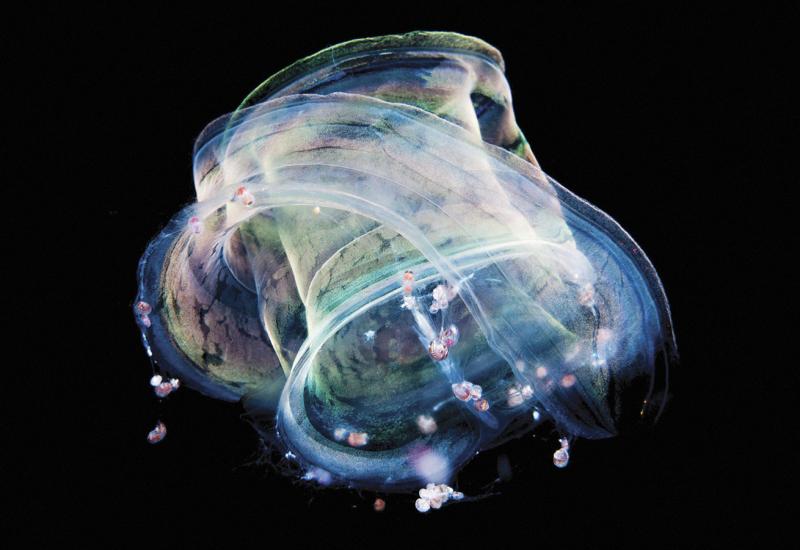Altitude Diving: The Challenges and Benefits for Scuba Divers

Gerald NowakDivers on the shore of the lake Samaranger.
Not all amazing dives happen below sea level. Some of the rarest and most interesting underwater environments are found at sites that exist far above that universal zero elevation. Scattered around the planet are high-altitude dives that only a select few have had the privilege—or resolve—to experience.
In 1968, Jacques-Yves Cousteau and his team explored the depths of South America’s Lake Titicaca in search of ancient Inca treasure at an altitude of more than 12,000 feet. Other notable high-altitude dives were done at around 19,400 feet in 1982 by Charles Brush and Johan Reinhard at Lago Licancabur in the Chilean Andes mountains, and in 2007 at approximately 20,000 feet by Philippe Reuter, Claudia Henríquez and Alain Meyes at Acamarachi, a volcano in Chile. The highest recorded dive in North America was done in 2013 by John Bali in Pacific Tarn Lake in the Rocky Mountains at an elevation of 13,420 feet.
These extreme-altitude escapades don’t necessarily characterize what’s accessible to divers today. By looking beyond the traditional boundaries of scuba diving, intrepid explorers can find uncommon adventures, as well as challenges to take your skills to the next level. Technical diver and instructor John Adsit knows the feeling.
For the owner of Deep Adventure Scuba in Boulder, Colorado, learning to dive at high altitude was a necessity of living landlocked at the foot of the Rocky Mountains near 5,400 feet.
“I started the business so I could have more people to dive with in the area,” he says. “I figured the only way I’m going to be able to do the dives I want to do in my area is to certify some people who can dive to the depths that I want to dive.
For his students, altitude is a necessary component of every course. When he’s not adding to the ranks of the Colorado diving population, Adsit frequents the private, high-altitude (just more than 4,600 feet) tec-diving destination of Rock Lake in Santa Rosa, New Mexico, which is also home to the popular Blue Hole, about seven hours south of Boulder. There he’s done several hundred dives, as well as many at other sites around the region above 10,000 feet.
“I love the adventure of it, and the feeling that you’re not just drifting along a reef looking at stuff; you’re doing skills at a higher level,” he says. “There is a satisfaction that you get having achieved the skills required to work at that level.”
But you don’t have to be a hardcore tec diver with a taste for trimix to get high. With the right motivation, plan and preparation, most any diver can elevate their game.
Adjust Your Plan
The fundamentals of diving don’t change at high altitude. Breathe in. Breathe out. Enjoy. However, the dive plan you follow to maintain proper decompression limits must be adjusted based on your altitude in order to maintain your safety. Thankfully, it’s not rocket surgery. But there are a few important factors to consider.
“When you are diving, the pressure you are under is a combination of the weight of the water and atmosphere,” Adsit says. “At altitude, the weight of the water is the same as at sea level, but the atmospheric pressure is less.”
Introduction to Cave Diving: What It Takes to Get Cave Certified
Essentially, the higher the altitude, the greater the change in pressure through the first 30 feet of depth underwater because the ambient air pressure is less at altitude than it is at sea level and it decreases as you move higher. To compensate, adjust your dive plan.
“When you are at depth, the total pressure is not much different from sea level because the water is supplying most of the weight, which means you on-gas at almost the same rate as at sea level,” he says. “As you ascend and begin to off-gas, there is still not much difference at first, so you off-gas at about the same rate as well, but when you start getting near the surface, and especially when you reach the surface, the lesser weight of the atmosphere becomes more important. With less ambient pressure at altitude, you may not have off-gassed enough to be safe.”
Training is the first step for preparing to make a dive at high altitude, which is commonly recommended as beginning at 1,000 feet above sea level.
A basic rule of thumb is, if you’re diving at altitude, stay shallow and keep it short to limit the amount of accumulated gas in your tissue. And be extra conservative during your ascent.
“The importance of this difference depends on both your depth and your altitude, whereas a diver doing a relatively shallow, no-decompression dive at a few thousand feet elevation will not have too much to be concerned about, but a deep diver, especially a technical diver, at greater elevation very much needs to be concerned,” Adsit says. “The most fundamental thing for recreational divers to understand is that as they get shallow, they have to be careful, ascend more slowly, and make a longer safety stop.”
Training is the first step for preparing to make a dive at high altitude, which is commonly recommended as beginning at 1,000 feet above sea level. Many training agencies, including PADI, NAUI and SDI/TDI, offer an altitude specialty as part of an advanced course. Knowledge is power. And think of the possibilities an understanding of altitude diving can open.

Gerald NowakScuba diver in Samaranger Lake.
Expand Your Horizons
“Exotic” takes on a deeper meaning when you consider the options available for high-altitude diving. Mountain lakes and lagoons invite exploration where few have gone before. And many are closer to home than you might think.
“A lot of people, especially those who live at high altitude like me, make the mistake of thinking they have to get on a plane and fly 3,000 miles to go to a great dive site, when they actually could have a very fun diving experience just a few miles away,” Adsit says.
In the U.S., Lake Tahoe—on the border between California and Nevada—tops many domestic lists for clean, clear water at 6,200 feet in the Sierra Nevada, albeit in temperatures ranging from 40 degrees F during winter to 60 in summer.
Yellowstone National Park in Wyoming is another travel target, with strange and wonderful geothermal springs at around 7,700 feet.
Europe offers cold mountain lakes in Austria and ice diving in the Pyrenees Mountains between France and Spain. Lake Atitlán at around 5,100 feet presents divers a chance to explore a volcanic crater in the highlands of Guatemala.
The Fuji Five Lakes district of Japan boasts freshwater diving with topside views of the region’s namesake mountain peak.
And these are just a few of the unusual possibilities for divers who get high.
The Hack: Cross Corrections
Some experts, including Divers Alert Network, suggest using the sea-level dive tables you’re familiar with to plan high-altitude dives but with Cross corrections that correlate to your altitude, or the U.S. Navy Diving Manual’s corrected table that provides equivalent depths at altitude. To calculate an “equivalent depth” to use in your adjusted plan, multiply the planned depth of the dive by the pressure at sea level divided by the pressure of the altitude at the site. Use that equivalent depth with your preferred table to plan the dive. Or use a dive computer that has been adjusted for your altitude—be aware that some models compensate for altitude automatically, while others require manual changes. See your owner’s manual for details.










